Sometimes, team members need a highly structured approach to perform more effectively.
Leaders often require team members who are underperforming in a critical area to agree to such a personalized map for self-improvement. For those in Human Resources, such a structured plan is typically called a PIP (Performance Improvement Plan).
In many circumstances, completing a PIP is the last chance for a team member to prove their worth and reset their standing within the team.
As such, it is a formal document that lays out the need to improve performance deficiencies and outlines what the team member must do to remain in good standing.
In the best cases, they are a detailed and achievable roadmap for improvement. In the worst cases, PIPs represent a last-ditch effort to prove to the individual that they are not up to the tasks the team requires of them.
Good organizations and leaders tie clear consequences to PIPs. But they refrain from using them to send the kind of message that should otherwise be communicated more directly, without wasting anyone’s time.
While it may be the case that a leader desires one more data point to determine whether a team member is up to the daily challenge of performance, in too many cases, PIPs are used as a cudgel or as a forecast that termination is inevitable.
Good leaders avoid using them for anything but an honest attempt to make people stronger and to improve their effectiveness.
That said, constructive PIPs share a few key ingredients. In addition to clearly stating the goals and timeline, if there are consequences connected to successfully or unsuccessfully completing the Plan, they should be explicitly stated and not left unsaid or presumed.
Perhaps the most important part of the plan is the action steps outlined for improvement. The best PIPs have very specific tasks, experiences, or actionable steps that are often ordered in sequence. These steps should be small enough to be both manageable and achievable.
Any resources to support and aid in the team member’s improvement should be spelled out. In many cases, other team members, mentors, or experts are made available to assist their colleague in accomplishing one or more of the tasks.
Lastly, an effective PIP should specify when the leader will check in to track progress. Dates and times for these checkpoints are essential for everyone to take the process seriously and to avoid wasting unnecessary resources.
Most PIPs occur over a period of 30, 60, or 90 days, depending on the issues involved and the time it will take to demonstrate improvement. So, establishing check-ins along the way is a relatively simple decision.
The idea of a Performance Improvement Plan is to give a team member the structure and help they need to regain their footing. In the best cases, team members improve and reclaim their reputation as a good performer.
In less perfect cases, the leader and team member recognize that the deficiencies cannot be overcome.

The Ingredients of an Effective Performance Improvement Plan (PIP)
Sign-up Bonus
Enter your email for instant access to our Admired Leadership Field Notes special guide: Fanness™—An Idea That Will Change the Way You Motivate and Inspire Others.
Inspiring others is among the highest callings of great leaders. But could there be anything you don’t know, you haven’t heard, about how to motivate and inspire?
Could there really be a universal principle that the best leaders follow? A framework that you could follow too?
There is.
Everyone who signs up for Admired Leadership Field Notes will get instant access to our special guide that describes a powerful idea we call Fanness™ (including a special 20-minute video that really brings this idea to life).
